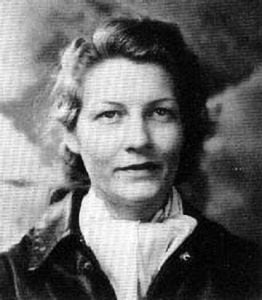 Paula Ruth Loop
Paula Ruth Loop
August 25, 1916 to July 7, 1944
Class: 43-W-2
Entered Army Air Force flight training: Houston Municipal Airport, Houston, Texas, December 19, 1942
Graduated: Avenger Field, May 28, 1943
Assignment: Ferry pilot
Training Location: Houston Municipal Airport (Tex.)
Assigned bases: Romulus Army Air Base (Mich.) and Fairfax Army Air Field (Kansas City, Kan.)
Planes flown: BT-15, C-47, B-24, B-25
(excerpt from To Live and Die a WASP)
Paula Ruth Loop was born in 1916 about 15 miles from the family farm in Manchester, Oklahoma. She was the first child of Elton Loop and Nettie Bartlett. She grew up near the town of Wakita, on the 160 acres claimed by her grandfather, George Loop, in the Oklahoma land rush of 1893. As the oldest child, Paula soon learned how to milk cows, can fruits and vegetables, sew, clean house, cook and take on all the chores expected of a farm child. She was a hard worker and when her three brothers and sisters began to arrive in 1920, she easily moved into the role of babysitter and attentive teacher.
In early 1939, President Roosevelt asked Congress for $7.3 million to establish a Civilian Pilot Training program administered by the Civil Aeronautics Authority (CAA), forerunner of today’s
Federal Aviation Administration. Europe was already moving toward war and there was a sense that if war broke out, the United States might need more pilots for self-defense and also combat pilots if the country was drawn into the conflict.
In December 1939, CAA announced that it would offer 700 flight scholarships to non-college students between the ages of 18 and 25 who didn’t have access to the pilot training program. … Students paid $30, which include a medical examination, ground school expenses, and insurance, with all other costs paid for by the CAA. At the end of the ground training, a competitive examination determined which 10 students received free flight training. There was one restriction. Of the final ten selected, only one could be a woman.
Maintaining a grade point average of 94.9, Paula was the first Oklahoma woman to receive one of the flight scholarships, entitling her to 35 hours of flight training at the Ponca City Municipal Airport. After her solo flight on September 22, 1940, she received her private pilot’s license.
With the announcement in September of a training program that would allow women to fly military aircraft, Paula, and eventually over a thousand other women, were finally able to use their flying ability in support of the United States war effort. She applied and met all qualifications, the most stringent of which was proving that she had flown over 200 hours. On December 13, 1942, she reported for training at the Howard Hughes Airport, Ellington Field, Houston, Texas. She was a student pilot in the second class given by the Army Air Force Women’s Flying Training Detachment. Six months later, her class graduated and Paula reported to the 3rd Ferrying Group at Romulus Army Air Field, near Detroit, Michigan.
One of her first assignments was to ferry a BT-13 Valiant two-seat trainer, from Enid, Oklahoma to Seattle, Washington.
Before leaving Sacramento, California, on her way north Paula wrote the last words the Loop family ever heard from their daughter and sister, “Next stop Medford, Oregon and then Seattle.”
In July 1944, just a few weeks shy of her 28th birthday, and 330 miles away from her destination, Paula died alone in a fiery crash.
Paula Loop’s trainer airplane, a BT-13 Valiant, had begun slicing through tall cedars in the middle of the afternoon. The left wing, nearly intact, sheared off from the fuselage and dropped about 150 feet from where the airplane ultimately struck the ground. The 60-gallon left wing fuel tank, still attached to the plane, erupted on impact, its contents exploding in a violent fire that quickly turned the remaining fuselage into a twisted skeleton framework of metal.
Why Paula’s plane had suddenly crashed, just a few minutes after refueling and takeoff from the Medford, Oregon airport, was never determined.
Though the military did not recognize Loop or any other of the other 37 women who died while in service to the WASPs, Tinker Air Force Base dedicated a building to her in Midwest City in 1980. Loop was named posthumously to the Oklahoma Aviation Hall of Fame in 2002.
Sources:
Findagrave.com
Honorstates.org
Texas Women’s University
William Miller blog
Women Airforce Service Pilots
There have been many books about the Women Airforce Service Pilots of WWII (WASP); however, hardly any about the 38 women who lost their lives while flying for the Army Air Corps. This book tells their story.





